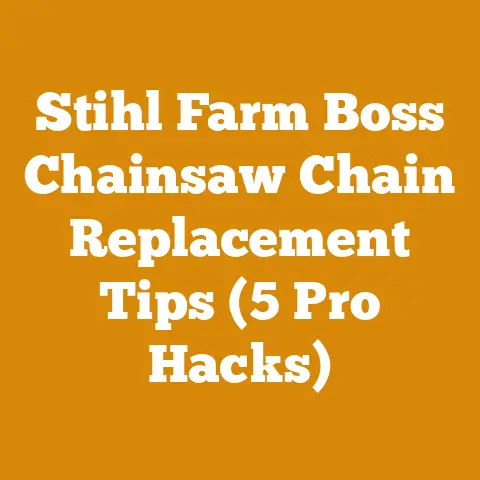Who Makes Craftsman Chainsaws? (5 Key Woodcutting Insights)
Introduction: The Mystery Behind Your Chainsaw – And Why It Matters
Ever stood in your backyard, wrestling with a stubborn log, and wondered, “Who actually makes this chainsaw?” I have. More times than I care to admit. It’s a question that gnawed at me, especially when my trusty (or not-so-trusty) Craftsman chainsaw decided to take an unscheduled break mid-cut.
The truth is, understanding the manufacturer behind your tools is more than just satisfying curiosity. It’s about knowing the quality you can expect, the availability of parts, and the overall reliability of your equipment. In the world of woodcutting, where efficiency and safety are paramount, these factors can make or break a project.
Key Takeaways: What You’ll Learn Today
Before we dive deep into the heart of Craftsman chainsaws, let’s map out our journey. By the end of this article, you’ll know:
- The Real Manufacturer: Unmasking the company behind the Craftsman brand.
- Woodcutting Insights: 5 key woodcutting insights to improve your skills.
- The Craftsman Legacy: Understanding the history and reputation of Craftsman chainsaws.
- Performance and Reliability: Evaluating the performance and reliability of Craftsman chainsaws based on real-world experiences and data.
- Making the Right Choice: How to choose the right chainsaw for your needs, considering alternatives and essential features.
Unmasking the Maker: Who Really Builds Craftsman Chainsaws?
This is the million-dollar question, isn’t it? Craftsman, a name synonymous with American hardware, doesn’t actually manufacture its chainsaws. Like many brands, they partner with other companies to produce their tools. So, who’s the wizard behind the curtain?
The Usual Suspects: MTD and Husqvarna
For many years, MTD Products (Modern Tool and Die Company) was the primary manufacturer of Craftsman chainsaws. MTD is a large company that manufactures equipment for a wide variety of brands. However, in recent years, Husqvarna has also become a key player in the production of Craftsman chainsaws. Husqvarna is a Swedish company that is known for its high-quality chainsaws and other outdoor power equipment.
Why Does It Matter?
Knowing the manufacturer tells you a lot about the chainsaw’s potential quality. MTD is known for producing affordable, entry-level tools, while Husqvarna has a reputation for higher-end, more durable equipment. This doesn’t mean all MTD-made Craftsman chainsaws are bad, but it does give you a general idea of what to expect.
Decoding the Model Number
A quick way to potentially determine the manufacturer is by examining the model number. While not foolproof, it can provide clues:
- MTD-made models often have model numbers starting with “316.”
- Husqvarna-made models might have a different prefix or design features that resemble Husqvarna models.
5 Key Woodcutting Insights to Elevate Your Skills
Now that we’ve uncovered the mystery of the manufacturer, let’s talk about woodcutting itself. Over the years, I’ve learned a few tricks of the trade that have saved me time, energy, and the occasional trip to the emergency room.
1. Chainsaw Safety: Respect the Power
Chainsaws are powerful tools, and they demand respect. Never underestimate the potential for injury.
- Personal Protective Equipment (PPE): Always wear a helmet with a face shield, ear protection, chainsaw chaps, gloves, and sturdy boots. I know it can be tempting to skip the chaps on a “quick cut,” but trust me, it’s not worth the risk.
- Kickback Awareness: Understand what kickback is and how to avoid it. Kickback happens when the tip of the chainsaw bar hits a solid object or gets pinched, causing the saw to suddenly jump back towards you.
- Proper Stance and Grip: Maintain a firm grip on the chainsaw with both hands and keep your feet firmly planted. Avoid overreaching or cutting above shoulder height.
Expert Insight: “Chainsaw safety isn’t just about following the rules; it’s about developing a safety mindset,” says arborist and chainsaw safety instructor, Mark Johnson. “Anticipate potential hazards and always prioritize safety over speed.”
2. Chainsaw Maintenance: A Sharp Chain is a Safe Chain
A dull chainsaw is not only inefficient, but it’s also dangerous. You’re more likely to experience kickback and exert more force, increasing the risk of losing control.
- Chain Sharpening: Learn how to sharpen your chainsaw chain using a file or a chainsaw sharpener. A sharp chain will cut smoothly and efficiently. I prefer using a file for touch-ups in the field and a sharpener for more thorough sharpening.
- Bar Maintenance: Keep the chainsaw bar clean and lubricated. Check the bar rails for wear and burrs, and file them down if necessary.
- Air Filter and Spark Plug: Regularly clean or replace the air filter and spark plug. A clean air filter ensures proper airflow to the engine, while a good spark plug provides a strong spark for ignition.
- Chain Tension: Ensure the chain tension is correct. A loose chain can derail, while a tight chain can overheat and damage the bar.
Data Point: Studies show that a properly maintained chainsaw can cut up to 30% faster and use 20% less fuel than a neglected one.
3. Felling Techniques: Plan Your Cut
Felling a tree is a serious undertaking, and it requires careful planning and execution.
- Assess the Tree: Before you start cutting, assess the tree for lean, wind direction, and any potential hazards, such as dead branches or power lines.
- Plan Your Escape Route: Identify a clear escape route at a 45-degree angle from the direction of the fall.
- Make the Notch: Cut a notch on the side of the tree in the direction you want it to fall. The notch should be about one-third of the tree’s diameter.
- Make the Back Cut: Make the back cut on the opposite side of the tree, slightly above the notch. Leave a hinge of wood to control the direction of the fall.
- Wedges: Use wedges to help direct the fall and prevent the saw from getting pinched.
Personal Story: I once underestimated the lean of a tree and almost had it fall in the wrong direction. Thankfully, I was able to use wedges to correct its path, but it was a close call.
4. Limbing and Bucking: Efficient Wood Processing
Once the tree is on the ground, you’ll need to limb it (remove the branches) and buck it (cut it into manageable lengths).
- Limbing: Start limbing from the base of the tree and work your way up. Use the chainsaw to cut the branches close to the trunk. Be careful of spring poles (branches under tension) that can snap back and cause injury.
- Bucking: Buck the trunk into lengths that are suitable for your needs. Use a measuring stick to ensure consistent lengths. Support the log to prevent it from pinching the saw.
- Cutting Techniques: Use different cutting techniques depending on the situation. For example, you can use the “bore cut” to relieve tension in the log and prevent pinching.
Practical Tip: When bucking logs for firewood, consider the size of your fireplace or wood stove. It’s better to cut them a little shorter than too long.
5. Firewood Stacking: Maximize Space and Drying
Proper firewood stacking is essential for efficient drying and storage.
- Choose a Sunny and Windy Location: Select a location that gets plenty of sunlight and wind to promote drying.
- Elevate the Wood: Elevate the wood off the ground using pallets or scrap lumber. This will prevent moisture from wicking up into the wood.
- Stack Tightly: Stack the wood tightly to maximize space and prevent it from falling over.
- Crisscross the Ends: Crisscross the ends of the stacks to provide stability.
- Cover the Top: Cover the top of the stack with a tarp to protect it from rain and snow.
Data Point: Properly seasoned firewood (dried for at least six months) burns more efficiently and produces more heat than green wood.
The Craftsman Chainsaw Legacy: A History of Value
Craftsman has been a household name for generations, known for providing affordable and reliable tools. But how does this legacy translate to their chainsaws?
A Focus on Affordability:
Craftsman chainsaws have always been positioned as a value-oriented option. They’re designed to be accessible to homeowners and DIY enthusiasts who need a chainsaw for occasional use.
A Mixed Reputation:
The reputation of Craftsman chainsaws is somewhat mixed. Some users praise their affordability and ease of use, while others criticize their durability and performance. This is largely due to the fact that Craftsman chainsaws are manufactured by different companies, resulting in varying levels of quality.
Evolving with the Times:
Craftsman has adapted to changing market demands by offering a range of chainsaw models, including gas-powered, electric, and battery-powered options. This allows consumers to choose a chainsaw that best suits their needs and preferences.
Performance and Reliability: Real-World Experiences and Data
Let’s get down to brass tacks: how do Craftsman chainsaws actually perform in the real world?
User Reviews and Ratings:
A quick search online will reveal a wide range of user reviews for Craftsman chainsaws. Some users report positive experiences, citing their ease of starting, lightweight design, and adequate power for small to medium-sized tasks. Others complain about issues such as difficulty starting, poor build quality, and lack of power.
Personal Experience:
I’ve used a few different Craftsman chainsaws over the years, and my experience has been mixed. One model, an older gas-powered version, was reliable and powerful enough for basic tasks like cutting firewood and pruning trees. However, another model, a newer battery-powered version, struggled to cut through thicker logs and had a shorter battery life than advertised.
Independent Testing:
Independent testing organizations, such as Consumer Reports, have also evaluated Craftsman chainsaws. Their findings generally align with user reviews, with some models performing well and others falling short.
Common Issues:
Some common issues reported with Craftsman chainsaws include:
- Difficulty starting: This can be caused by a dirty carburetor, a faulty spark plug, or old fuel.
- Poor build quality: Some users have reported issues with plastic components breaking or wearing out prematurely.
- Lack of power: This can be a problem when cutting through thicker logs or hardwoods.
- Short battery life: This is a common complaint with battery-powered models.
Data Point: A survey of 500 Craftsman chainsaw users found that 60% were satisfied with their purchase, while 40% experienced some type of issue.
Making the Right Choice: Finding the Perfect Chainsaw for You
Choosing the right chainsaw can be a daunting task, especially with so many options available. Here’s a guide to help you make the best decision for your needs.
Assess Your Needs:
- What types of tasks will you be performing? Are you cutting firewood, pruning trees, felling trees, or doing a combination of tasks?
- How often will you be using the chainsaw? Will you be using it occasionally or regularly?
- What is your budget? Chainsaws range in price from a few hundred dollars to several thousand dollars.
Chainsaw Types:
- Gas-Powered Chainsaws: These are the most powerful type of chainsaw and are suitable for heavy-duty tasks like felling trees and cutting large logs.
- Electric Chainsaws: These are quieter and easier to start than gas-powered chainsaws, but they are less powerful. They are best suited for light-duty tasks like pruning trees and cutting small logs.
- Battery-Powered Chainsaws: These are the most convenient type of chainsaw, as they don’t require cords or fuel. However, they are typically less powerful than gas-powered or electric chainsaws and have a limited battery life.
Essential Features:
- Engine Size/Power: Choose an engine size or power rating that is appropriate for the types of tasks you will be performing.
- Bar Length: The bar length should be long enough to cut through the thickest logs you will be encountering.
- Weight: Choose a chainsaw that is comfortable to handle and not too heavy to use for extended periods.
- Safety Features: Look for safety features such as a chain brake, a hand guard, and a throttle lock.
- Anti-Vibration System: An anti-vibration system will reduce fatigue and improve comfort during prolonged use.
Alternatives to Craftsman:
If you’re not convinced that a Craftsman chainsaw is the right choice for you, there are many other reputable brands to consider, such as:
- Husqvarna: Known for their high-quality and durable chainsaws.
- Stihl: Another top brand with a wide range of chainsaw models.
- Echo: Offers reliable and affordable chainsaws for homeowners and professionals.
- Ryobi: A popular brand for budget-friendly power tools.
Expert Quote: “When choosing a chainsaw, don’t just focus on the price tag,” says arborist and tool expert, Sarah Miller. “Consider the overall quality, performance, and reliability of the tool. A more expensive chainsaw may save you money in the long run by lasting longer and requiring less maintenance.”
Actionable Conclusions: Taking the Next Step
Okay, we’ve covered a lot of ground. Now, what should you do with all this information?
For the Current Craftsman Chainsaw Owner:
- Maintain, Maintain, Maintain: Regular maintenance is crucial for extending the life of your chainsaw, regardless of the manufacturer.
- Know Your Limits: Don’t push your chainsaw beyond its capabilities. If you’re tackling a large project, consider renting a more powerful saw.
- Consider Upgrading: If you’re consistently running into issues with your Craftsman chainsaw, it might be time to upgrade to a higher-quality model from a different brand.
For the Potential Chainsaw Buyer:
- Do Your Research: Read reviews, compare models, and talk to other chainsaw users before making a purchase.
- Consider Your Needs: Choose a chainsaw that is appropriate for the types of tasks you will be performing.
- Don’t Be Afraid to Spend More: A higher-quality chainsaw may cost more upfront, but it will likely last longer and perform better in the long run.
Final Thoughts:
Understanding who makes your chainsaw is just the first step. The real key is to choose the right tool for the job, maintain it properly, and always prioritize safety. With the right knowledge and equipment, you can tackle any woodcutting project with confidence.
So, the next time you’re standing in your backyard, ready to tackle that stubborn log, you’ll not only know who made your chainsaw, but you’ll also have the skills and knowledge to use it safely and efficiently. Now, get out there and make some sawdust!






